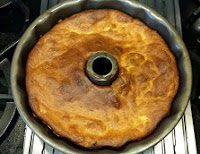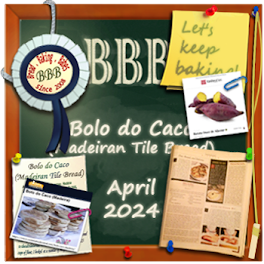Founder and inspiration, Zorra, announced in early January that this would be the final BBD. In its honor, we were challenged to bake a yeasted Kugelhopf/Gugelhupf.
Years ago, when baking with the Tuesdays with Dorie group, one of the recipes was a Kugelhopf. Although I could have made it a second time, I decided to find a new recipe. I chose this one from David Lebovitz, and it was definitely an excellent choice. In addition, it allowed me to use some of the orange flower water that I had purchased for a previous bread recipe, Fouace Nantaise.
I tweaked the recipe in little ways. I used golden raisins, soaked in dark rum, and a combination of lemon and clementine zest.
For the soaking glaze, I used the orange flower water -- a healthy tablespoon-full. Since I still don't have a kugelhopf pan, I used my bundt pan. On a sadder note, the last of my favorite yeast went into this bread. I've had it for many years and never doubted its potency. The large package was stored in the freezer, and I decanted out a small jar for the fridge, refilling it when necessary. I'm hoping its successor will be just as reliable.
Stop by Zorra's website in the next few days to see all the beautiful kugelhopfs. Thanks, Zorra, for all the wonderful bread baking challenges. I will definitely miss the fun.
I'll definitely miss this bread as well. I shared some with friends, but it's too delicious to last very long!
Kugelhopf
| (from David Lebovitz) |
| 8 servings |
Ideally, you want to use a high-sided Kugelhof mold or bundt pan that has a 6 to 8 cup (1,5-2l) capacity. I made it in a larger-sized bundt pan (10-inch/25cm) and it works fine, but the cake will be lower than a traditional Kugelhopf and will take less time to bake.
I don't use instant yeast (nor did I use fresh cake yeast for this cake), but if you want to use one of those, check the manufacturer's website for instructions on substituting them for the active dry yeast.
Sponge
1/2 cup (125ml) whole or lowfat milk
3 tablespoons sugar
2 1/4 teaspoons (1 envelope, 7g)) active dry yeast
2/3 cup (90g) flour
Dough
1/2 cup (80g) raisins
10 tablespoons (5 ounces, 140g), unsalted butter, cubed, at room temperature, plus additional soft butter for preparing the pan
1/2 teaspoon salt
2 teaspoons lemon or orange zest
1 teaspoon vanilla extract
1 large egg, at room temperature
1 large egg yolk
1 cup (140g) flour
1/3 to 1/2 cup (30-40g) sliced almonds, blanched or unblanched, for preparing the cake pan
One 6- to 8-cup kugelhopf pan, or a 10 cup/25cm bundt pan (see headnote)
1.
Make a sponge by warming the milk over low heat in a small saucepan
until it’s tepid. Pour into the bowl of a stand mixer, add the sugar,
and sprinkle in the yeast. Stir in 2/3 cup (90g) flour. Cover with a
kitchen towel or plastic wrap and let rise until bubbly, about 20
minutes.
2.
Butter the inside of a kugelhopf mold or bundt pan very well then
scatter sliced almonds over the inside of the mold, pressing them in a
bit and turning the mold so there is a relatively even coating of
almonds. Gently tilt out any excess almonds.
3. In a small bowl, stir together the raisins and the rum, and set aside.
4.
Add the cubed butter to the sponge and attach the bowl to the mixer.
Using the paddle attachment, beat the butter with the salt, citrus zest,
and vanilla until incorporated.
5. Beat in the egg and the yolk until smooth. Stop the mixer and scrape down the sides of the bowl
6.
On low speed, mix in the 1 cup (140g) of flour. Once the flour is
incorporated, increase the speed to high and beat until smooth, shiny
and elastic, about 3 minutes.
7. Beat in the raisins and any liquor in the bowl.
8.
Cover the bowl with a kitchen towel or plastic wrap and let rise in a
warm place until the dough begins to puff, about 30 minutes.
9.
Make a hole in the center of the dough with your hands and stretch the
dough out so the hole will be is large enough to go around the center of
the kugelhopf mold or pan. Lift and transfer the dough into the cake
pan. Make sure it's of even thickness all the way around. (A damp hand
works well for that.)
Cover the mold with a kitchen towel or buttered plastic wrap. Let rise
until doubled, 1 to 1 1/2 hours. If using a kugelhopf mold, it should
reach to the top, or almost to the top, of the mold. If using a larger
bundt pan, it will likely take the maximum amount of time to rise.
10.
Fifteen minutes before the dough is fully risen, preheat the oven to
375ºF (180ºC). Bake the kugelhopf until it’s deep golden brown across
the top, about 40-45 minutes. (In a large bundt pan, the cooking time
will be closer to 25 minutes.) When done, a toothpick inserted into the
center should come out clean. Let the cake cool for 10 minutes.
11.
While the cake is baking, make a glaze by bringing 1/3 cup of water
(80ml) and 1/3 cup (65g) of sugar to a boil. Remove from heat once the
sugar is dissolved and add 1 ½ teaspoons of orange flower water or 2
tablespoons of rum or kirsch. Poke the kugelhopf 35 times with a skewer
and liberally brush half of the syrup over the cake, repeatedly, letting
it absorb.
Turn the cake out of the pan onto a cooling rack set over a baking sheet
(to catch any dripping syrup), and brush the rest of the syrup,
repeatedly, over the top and sides (and the inside hole) of the cake.
Cool completely before slicing and serving.
Storage: The kugelhopf is better served the same day, or the day after it's made. Store at room temperature, well-wrapped.












